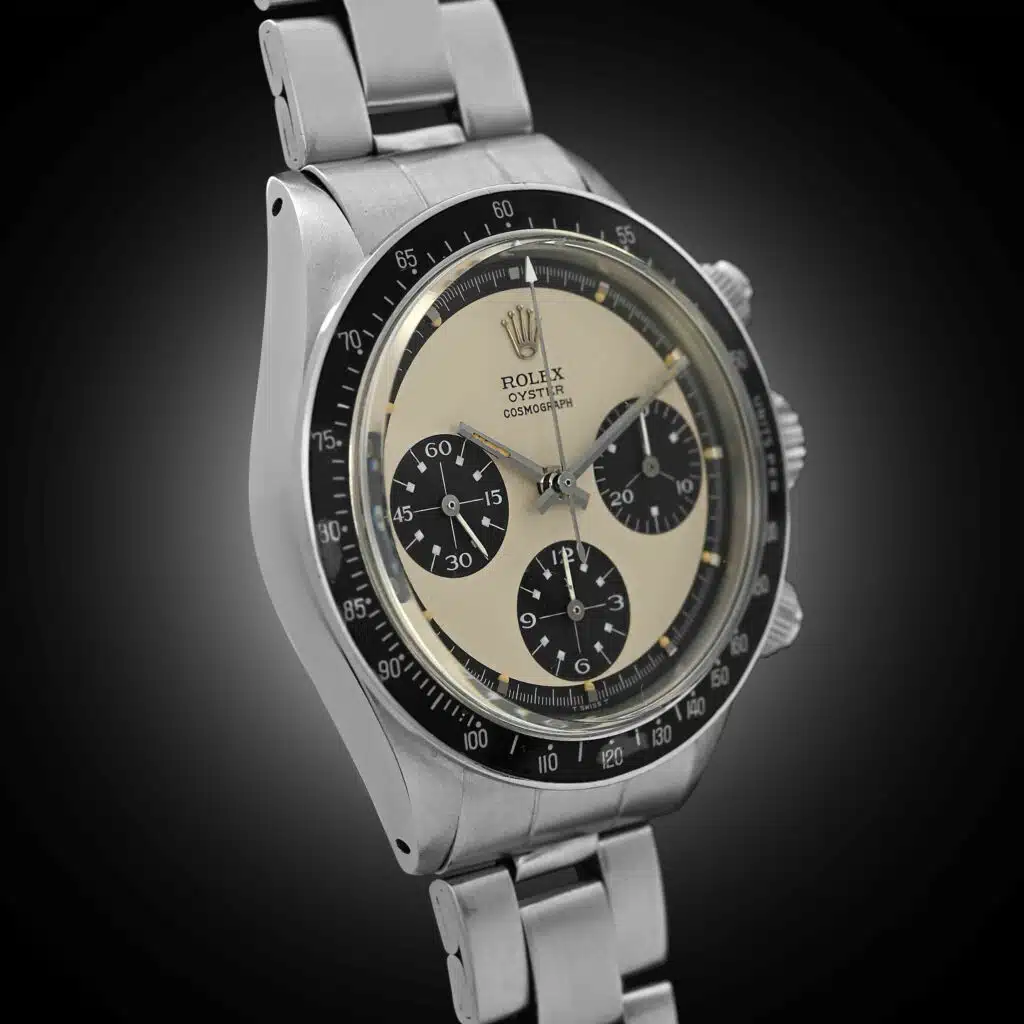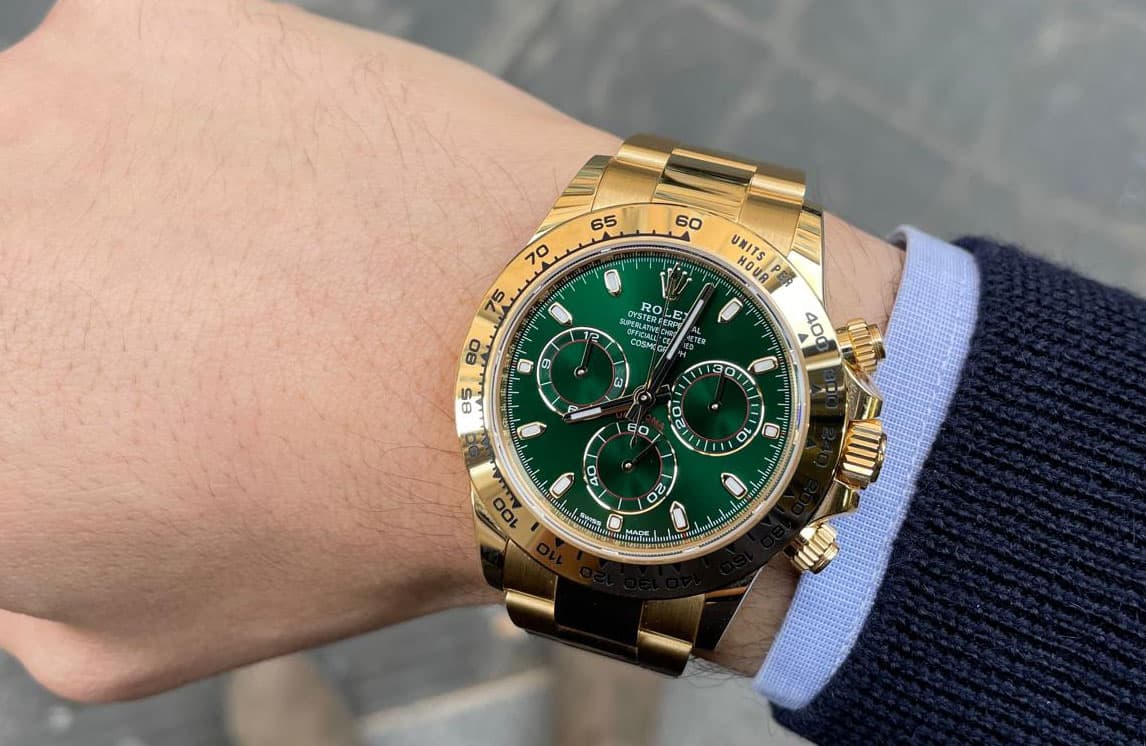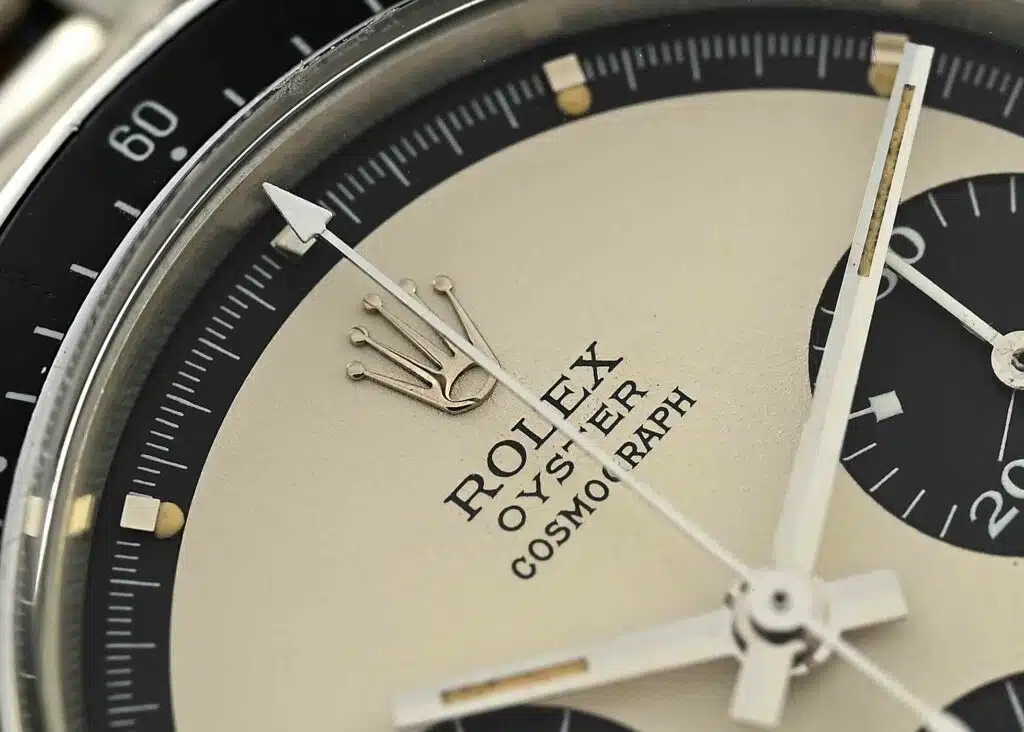
The term Paul Newman refers to a specific variant of Rolex Daytona dials that became popular in the 1980s with modern watch collectors. These watches, known for their distinctive designs with "tropical," panda (white background and black subdials) or reverse panda (black background and white subdials) dials, share the Daytona case and movement but are distinguished by some subtle and unique dial details. Only those models with specific reference numbers (6239, 6240, 6241, 6262, 6263, 6264, 6265) and special features, such as the 1972 ref. 6263 MK 2 visible on this page, are considered true Paul Newman.
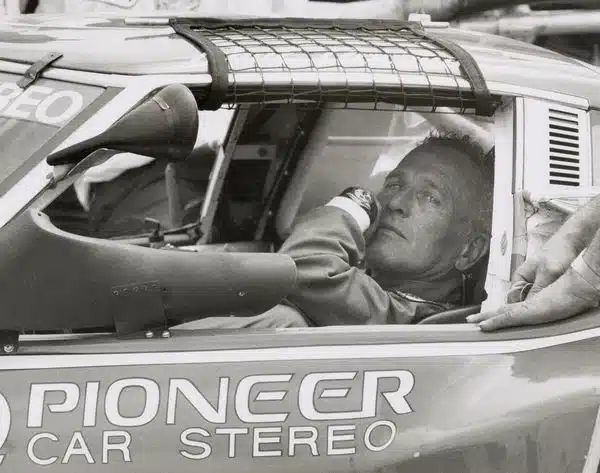
At a time roughly coinciding with the filming of the movie "Winning," which was released in theaters in 1969 (in Italy with the fanciful title Indianapolis hellish track), Joanne Woodward gave her husband a perfect gift: a Rolex Cosmograph Daytona reference 6239 made in 1968 and-at least giving credence to the communication of those years-specifically designed for motorsports.
Joanne, a great actress but also a woman of refined taste, probably chose this dial example that today we would call "exotic" at Tiffany & Co. on New York's Fifth Avenue, as evidenced by the hand-engraved inventory numbers on the lugs. A tender dedication "DRIVE CAREFULLY ME" ("drive carefully" although the actual meaning is still being debated...) was engraved on the case back by Joanne, reflecting her concerns about her husband's propensity for speed.
After all, only three years earlier, in 1965, Newman had been injured in a serious motorcycle accident that required skin grafts on his left hand. With those memories still vivid, Joanne felt great discomfort whenever he ventured out on the track. The Daytona thus became a faithful companion for Newman, used as a veritable tool to time his racing activities.
So proud and confident of his accuracy, Newman would bet his friends that his Daytona was more accurate than theirs. After verifying the exact time through the Central Time telephone service, Newman would cash in his winnings. Amaved his Rolex and loved to be on time.. In 1984, this Daytona apparently "disappeared" when he received a new watch-a Cosmograph Daytona with a black, non-exotic dial, Reference 6263, purchased again for him from Joanne Woodward.
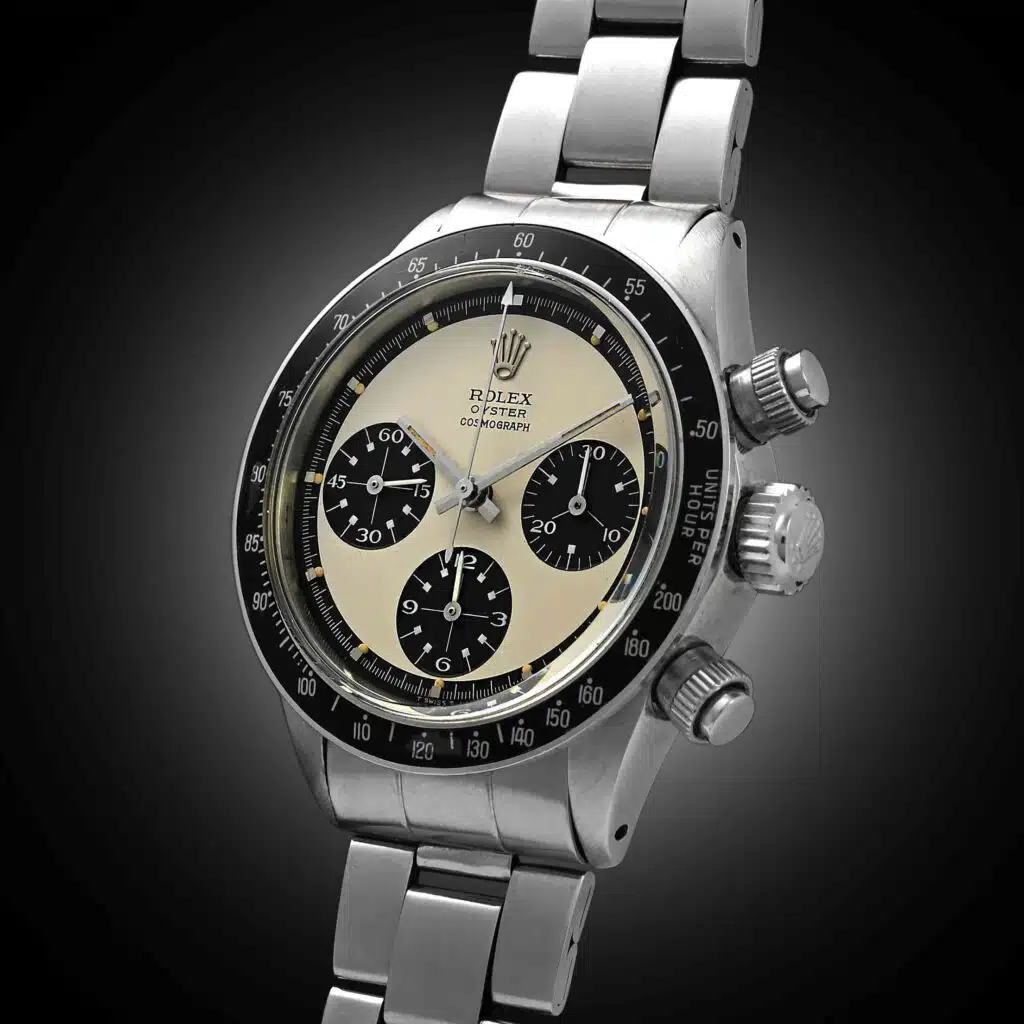
We would have to wait until the late 1980s, and the birth of modern watch collecting, to find the term "Paul Newman dial" generically attributed to "tropical" dials either with a white background and black counters (the graphic we now call "panda") or with a black background and white counters (a graphic we now also refer to by the nickname "reverse panda").
Although they share the case and movement of the entire Daytona collection, the "Paul Newman" have distinctive features on the dial that differentiate them from the other variants in this collection. However, the details that give these watches their unique character can be so subtle that they are easily missed by the uninitiated. To begin with, it is important to know that a Daytona "Paul Newman" is a sports watch and can only have the reference numbers 6239, 6240, 6241, 6262, 6263, 6264 o 6265. In addition, they all feature acrylic domed glasses. Another distinctive feature is the sub-dials: instead of the usual lines, the sub-dials include block markers, and crosses are placed in the center of each sub-dial. The seconds sub-dial, in particular, features indications at 15, 30, 45 and 60. In other Daytona models, these are located at 20, 40 and 60.
Going into the specifics, the Paul Newman steel with Oyster case and Panda dial(like the one visible in the photo, an extraordinary Ref. 6263 MK 2) with ivory back and counters and outer track in black, was made with references 6263 and 6265. The lettering arrangement is the traditional ROC (from the top Rolex, in the middle Oyster and below Cosmograph).
In spite of a production that has counted very few examples put on the market, for the panda dials we can recognize, in accordance with what the latest research has shown, as many as four variants: MK 1, MK 1.5, MK 1.75 and MK 2. What essentially differentiates them is the shape and graces of the font used on the Rolex R and E (see the fine research work carried out by Grégoire Rossier and Anthony Marquié on their volume Rolex Cosmograph Daytona), along with the shape of the 3 in the supplementary subdials. Also significant for each variant is the distance between the logo and the Rolex inscription, which varies according to the version and is in any case significantly greater in the MK 1.75 than in the others. In any case, it is always a good idea to avoid the "do-it-yourself" approach, and to recognize and evaluate a Paul Newman it will always be best to turn to someone who "frequents" watches of this importance and rarity on a daily basis and can therefore validate and evaluate all its distinctive features.
More generally, models such as the Ref. 6263 MK 2 in the photo, distinguished not only by its rarity but also by its extraordinary state of preservation, are the ones that have made the Paul Newman an object of desire for collectors and watch enthusiasts the world over. Its rarity, combined with the legend associated with the famous actor and the technical specifications that distinguish it, make it a priceless collector's piece.
As all great collectors have well understood by now, the value of a "Paul Newman" Daytona lies not only in its being a precision timepiece made by one of the world's most prestigious watchmakers, but also and above all in its aesthetic and historical features, which make it a true symbol in the world of watchmaking and a museum piece for enthusiasts and collectors.
How did the story of Paul Newman's Paul Newman turn out?
The fate of the watch after its disappearance in 1984 remained one of the greatest watchmaking mysteries of the 20th century-until the consignee, James Cox, revealed the watch and its fascinating history. In fact, the Cosmograph Daytona had never 'disappeared': it was given directly by Paul Newman to Cox, creating an incredible entanglement related to Paul Newman and Mrs. Woodward's first daughter, Elinor "Nell" Newman. Nell was a beautiful, intelligent, girl-next-door type of girl. Humble like her father, she never boasted of her famous origins. She attended the College of the Atlantic in Bar Harbor, Maine. During her studies, she kept her identity a secret, using her stage name, Nell Potts. In the fall of 1983 she began dating a fellow student - James Cox.
During a dinner with a group of students, Nell brought a bottle of "Newman's Own" salad dressing. At the sight of Paul Newman's face on the bottle, James recounted meeting Paul Newman as a child at the Lime Rock race track. He was behind a rope, trying to take a picture of drivers in their cars, when he was noticed by a driver in a full suit who signaled for him to move closer to the track to take a better picture. The driver, he recounted, was Paul Newman.
It was after hearing this story that Nell revealed her true identity to James. Her name was not Nell Potts, but rather Nell Newman. Nell diligently concealed her origin under this alias to protect herself from anyone who had bad intentions and tried to become her friend for the wrong reasons. Needless to say, James fell in love with her and not her famous background, and the two continued to date for almost a decade.

In the summer of 1984, both Nell and James were staying at the Newman family home in Westport, Connecticut. She was working as an assistant in Vermont, helping peregrine falcons return to the wild. James stayed in Westport with Paul Newman and came up with the idea of rebuilding the tree house on the main property, known as the "Nook House." This tree house was the reason that convinced Joanne Woodward to purchase the house. For Paul and Joanne, it represented the most important feature of Nook House, essential to the longevity of their extraordinary 50-year marriage.
As described by Nell Newman in a signed letter accompanying the clock in question, "Dad often went to the riverbank to check on James's progress. On one such occasion, he asked James if he knew what time it was. Apparently that morning Dad had forgotten to wind his wristwatch. James replied that he did not know the time and did not own a watch. Dad handed him his Rolex, saying, 'If you can remember to wind it every day, that's pretty good with the time." Since that day, James has treasured the watch and preserved it in its original condition.
The even personal affair that accompanies Paul Newman's watch is not only a fascinating page of horological history, but also a window into the private lives and personal relationships of one of Hollywood's most beloved couples. The intimacy of Joanne Woodward's gesture of engraving an affectionate reminder on the back of her husband's watch speaks of a deep awareness and concern for her partner's well-being. The subsequent transmission of the watch from Paul Newman to James Cox, under the blessing of a significant family moment, adds another layer of personal and historical significance to this piece.
This Rolex Daytona is not only a silent witness to the races and challenges experienced by Newman, but also a symbol of love, affection, and human connections that transcend time and generations. In a world where objects are often valued for their material value, his story reminds us that true value lies in personal stories and the emotional connections they represent. Speaking of "valuations," Paul Newman's Daytona Paul Newman was sold by Phillips in Association with Bacs & Russo for $17,752,500 during the Winning Icons - Legendary Watches of the 20th Century auction held in New York on Oct. 26, 2017.
